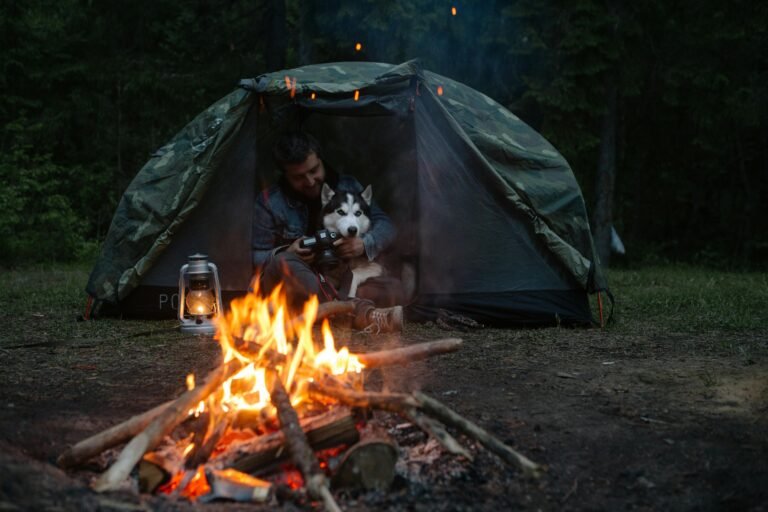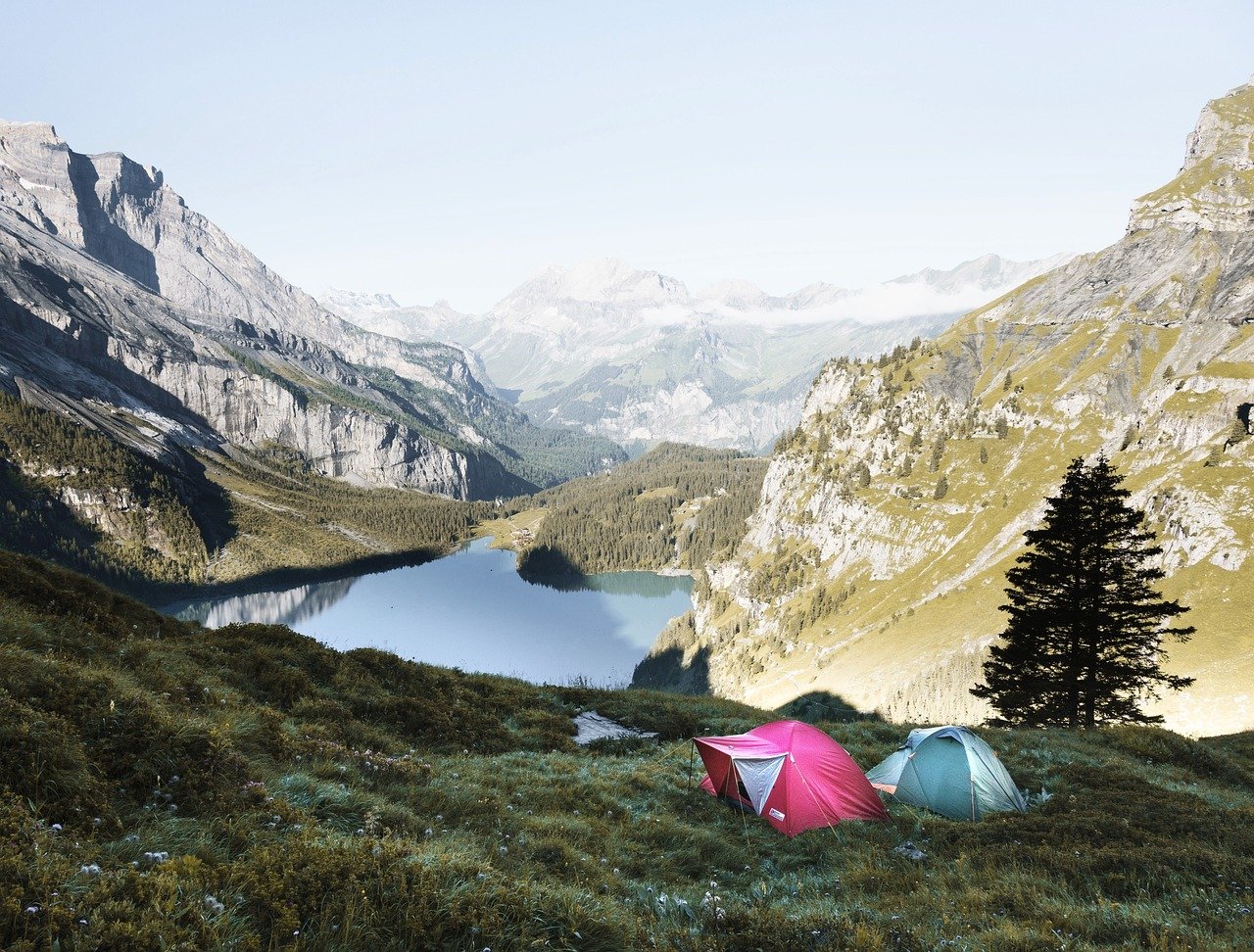Camping Essentials: Must-Know Tips
As hiking enthusiasts, it’s only a matter of time before we venture into the complementary thrill of camping.
This dynamic duo offers the chance to fully immerse yourself in nature, turning a simple day hike into a memorable overnight adventure. But how can we ensure our experience is both safe and enjoyable?
From selecting the perfect campsite and packing the right gear to anticipating weather conditions and planning nutritious meals, there’s a lot to consider.
In this guide, we’ll cover all the camping essentials to help you create a seamless and unforgettable camping experience. Get ready to take your outdoor adventures to new heights!
1. Choosing the Right Campsite Location
Selecting the right location for your campsite is crucial for both safety and comfort. The mountains offer a wide variety of stunning landscapes, but not all areas are suitable for camping. Here’s what you need to consider when picking your campsite.

Choosing the Perfect Terrain for Your Camping Adventure
Look for a flat, level area to set up your tent. Avoid places with excessive slopes, as water can collect and flood your campsite during rain.
Identifying and Utilizing Water Sources for Your Camping Trip
When camping, having a nearby water source—such as a river, stream, or lake—makes it easier to access water for drinking, cooking, and cleaning.
However, it’s crucial to avoid pitching your tent too close to the water. Not only can this reduce the risk of flooding during unexpected rain or rising water levels, but it also helps protect the natural environment and wildlife that rely on these water sources.
As a general rule, set up your campsite at least 200 feet (about 70 meters) away from the water. This distance ensures both safety and minimal ecological impact.
Effective Wind Protection Strategies for Your Campsite
Mountainous regions are known for their strong and unpredictable winds, so selecting a well-sheltered campsite is critical for both safety and comfort. Here are some key strategies to protect your campsite from the wind:
Choose a Natural Windbreak:
Look for natural barriers such as large rocks, boulders, dense tree lines, or ridges that can shield your tent from strong gusts. If possible, position your tent on the leeward side of these features (the side away from the wind).
Avoid Exposed Areas:
Steer clear of open ridges, hilltops, or flat, exposed fields where the wind can hit with full force. Similarly, avoid setting up camp at the bottom of narrow valleys, as these areas can act as wind funnels, intensifying gusts.
Position Your Tent Strategically:
Pitch your tent with its lowest and narrowest side facing into the wind to reduce drag. Many tents are designed aerodynamically, so make sure the strongest part of the structure (e.g., the poles or guy lines) is aligned to face the wind.
Secure Your Tent Properly:
Use extra stakes and guylines to anchor your tent securely. If the ground is soft or loose, use rocks or logs to weigh down your stakes for added stability. For high-wind areas, bring specialized stakes like snow or sand stakes if needed.
Keep a Safe Distance from Hazardous Elements:
Avoid camping directly under trees with dead branches, as strong winds can cause them to fall. Similarly, stay away from cliffs or loose rock formations that could become unstable in high winds.
Create an Artificial Windbreak:
If natural barriers are scarce, you can use gear like backpacks, tarps, or even snow (in winter camping) to create an artificial windbreak around your tent.

Opt for Low-Profile Gear:
If you frequently camp in windy conditions, consider investing in a low-profile tent designed to withstand high winds. Dome-shaped or geodesic tents tend to perform better than tall, cabin-style tents.
Monitor the Weather:
Always check the weather forecast before your trip to anticipate wind conditions. If strong winds are expected, plan your route and campsite accordingly to minimize exposure.
Balancing Sun Exposure and Finding Shade for Optimal Comfort
Consider the position of the sun—setting up your tent in a shady area can keep you cooler in the morning, while a sunny spot is ideal for warming up after a chilly night.
Managing sun exposure at your campsite is essential for staying comfortable and protecting yourself from the elements. Here are some tips to strike the right balance between sun and sha
Wildlife Considerations: Staying Safe and Respectful While Camping
Sharing the outdoors with wildlife is one of the joys of camping, but it’s important to take precautions to ensure both your safety and the safety of the animals. Here are some tips to consider:
Store Food Securely
Always store your food and scented items (toothpaste, soap, deodorant, etc.) in wildlife-proof containers like bear canisters or food lockers, if provided at the campsite.
Never leave food unattended and avoid storing it in your tent. Hanging food bags from a tree branch at least 12 feet off the ground and 6 feet from the trunk is another effective method.
Keep a Clean Campsite
Dispose of food scraps, wrappers, and garbage properly by packing them out or using designated trash bins. Even small crumbs can attract animals.
Clean cookware and utensils immediately after use, and avoid spilling food or drinks around your campsite.
Respect Wildlife from a Distance
Observe animals from afar to avoid startling them or making them feel threatened. Never approach, feed, or touch wildlife, as this can disrupt their natural behavior and endanger both you and the animal.
Use binoculars or a zoom lens for photography to maintain a safe distance.
Be Bear Aware

In bear country, learn about the types of bears in the area and carry bear spray as a precaution. Know how to use it and keep it accessible at all times.
If you encounter a bear, stay calm, avoid running, and slowly back away while speaking calmly. Make yourself look bigger if necessary.
Protect Against Smaller Pests
Raccoons, squirrels, and rodents are notorious for scavenging campsites. Store food securely and keep your tent zipped closed at all times to prevent unwanted visitors.
Shake out clothing, sleeping bags, and shoes to ensure no insects or small animals have found their way inside.
Watch for Insects and Reptiles
Use insect repellent and wear long sleeves and pants to protect against mosquitoes, ticks, and other biting insects.
Check your campsite for snakes or other reptiles, especially in rocky or desert areas. Watch where you step and where you place your hands.
Camp Away from Animal Trails and Water Sources
Avoid setting up camp near animal trails, dens, or burrows, as these areas are often frequented by wildlife.
Maintain a distance of at least 200 feet from water sources to prevent disturbing animals that rely on them.
Learn more about wildlife considerations.
Follow Local Regulations
Familiarize yourself with the rules and guidelines of the area you’re camping in, as some locations may have specific wildlife precautions, such as fire bans or bear warnings.
Pay attention to posted signs and ranger advice—they’re there to protect both campers and wildlife.
Be Noise-Aware
While it’s good to avoid excessive noise to enjoy nature, making subtle noise while hiking or moving around can alert animals to your presence, reducing the chance of startling them.
Leave No Trace
Practice the principles of Leave No Trace by minimizing your impact on the environment. This includes packing out all trash, avoiding damage to plants or habitats, and leaving the area as you found it.
Avoid Sensitive Ecosystems:
Make sure to camp in designated areas or established campsites to avoid disturbing fragile ecosystems or protected lands.
2. Setting Up Your Tent
Pitching your tent may seem like a simple task, but it’s important to do it correctly to ensure you have a safe, dry, and comfortable night’s sleep. Here are the key steps to setting up your tent in the mountains.
How to Set Up Your Tent:
Lay Down a Ground Tarp:
Before you pitch your tent, lay down a ground tarp to protect your tent floor from moisture and abrasions. Make sure the tarp doesn’t extend beyond the tent floor to avoid collecting water.
Stake the Tent Securely:
In mountain environments, wind can be strong, so it’s essential to secure your tent well. Use all of the tent’s guy lines and stakes to make sure it’s taut and stable. If the ground is rocky, use larger rocks or specialized sand anchors to secure the tent.
Proper Tent Orientation:
Set up your tent with the entrance facing away from prevailing winds. This will prevent wind from blowing into your tent and protect you from rain.
Ventilation:
Ensure your tent has proper ventilation to reduce condensation. Many tents have vents at the top to allow airflow, which helps avoid moisture buildup inside.
Consider Elevation:
In mountain terrain, the air can be colder at higher elevations. Be sure to pitch your tent at a lower area, such as near a valley or protected cove, to avoid frost and chilly winds that may accumulate in higher areas.
Tip: Test your tent at home before heading out on your mountain trip. Familiarize yourself with how to set it up in case of any issues during your trip.

3. Building a Safe and Efficient Campfire
Building a campfire is a classic part of the mountain camping experience, but it’s important to do so safely and responsibly to minimize your environmental impact. Mountain areas are often prone to wildfires, so campfires should be handled with great care.
Steps to Build a Safe Campfire:
Check for Fire Restrictions:
Many mountain areas prohibit campfires, especially during dry months. Always check if fire regulations are in place before you begin gathering wood.
Choose a Fire Pit or Safe Area:
If fires are allowed, use an existing fire ring or fire pit. If there isn’t one, dig a small pit and surround it with rocks to contain the flames.
Gather the Right Wood:
Use dead and downed wood for your fire—never cut live trees or branches. Start with small twigs and kindling, gradually adding larger logs as the fire grows.
Never Leave a Fire Unattended:
Always keep a close eye on your campfire and never leave it burning unattended. Keep a bucket of water or dirt nearby to extinguish the fire if necessary.
Extinguish the Fire Properly:
Before going to bed or leaving your campsite, ensure the fire is completely out. Pour water on the embers and stir to make sure no flames remain. The ashes should be cold to the touch.

Tip: Consider using a camp stove for cooking instead of a campfire. It’s more efficient, leaves less impact on the environment, and may be safer, especially in areas prone to wildfires.
4. Preparing Your Campsite for Cooking and Eating
Once your tent and campfire are set up, it’s time to prepare a place for cooking and eating. In the mountains, it’s especially important to keep your food secure to avoid attracting wildlife.
Planning your meals ahead of time is crucial for a successful camping trip. This not only ensures that you have enough food for the duration of your adventure, but also allows you to pack efficiently and minimize waste.
By preparing a detailed menu and organizing your meals by day, you can streamline your cooking process and enjoy a variety of delicious, nutritious options.
Consider factors like non-perishable ingredients, easy-to-cook recipes, and meal prep steps you can do in advance.
This thoughtful approach will enhance your camping experience, allowing you to focus more on the great outdoors and less on meal logistics.
Tips for Cooking and Eating:
Use a Designated Cooking Area:
Set up your cooking area away from your sleeping area and food storage to avoid attracting animals. Use a camping stove or portable grill for cooking, as it’s cleaner and safer than cooking over a fire.
Clean Up Immediately:
Wash your dishes at least 200 feet from any water source. Use biodegradable soap and pack out all trash. A small camp sink or a basin is handy for washing dishes without wasting too much water.
Store Food Securely:
Always store food in airtight containers or bear-resistant food storage canisters. In bear country, this is essential for your safety and the safety of wildlife.
Use a Trash Bag:
Pack out all trash, including wrappers, cans, and food scraps. Leave no trace of your presence in the wilderness.
Tip: If you’re planning to hike or explore during your camping trip, consider pre-packaged meals or ready-to-eat food options to make cooking easier at camp.

5. Staying Comfortable in different Conditions
Some environments can have unpredictable weather and temperature fluctuations, so it’s essential to stay comfortable and prepared for all conditions.
Here are a few tips to ensure your comfort throughout your camping adventure.
Dress in Layers:
The weather in the mountains can change quickly. Wear moisture-wicking layers to keep dry, with a warm insulating layer and a waterproof outer layer for protection against rain or wind.
Enhancing your comfort in cold weather, hand and foot warmers can be incredibly beneficial. They provide crucial warmth and help prevent frostbite and hypothermia, making your outdoor adventures safer and more enjoyable.
Bring a Sleeping Pad and Warm Sleeping Bag:
The ground in the mountains can be rocky or cold, so make sure to bring a sleeping pad for insulation. A quality sleeping bag rated for the expected temperature is essential to ensure a restful night.
Stay Hydrated and Fueled:
Carry enough water for your hike and camp stay. Use a water filter or purification tablets if you need to treat water from a nearby source. Eating energy-rich snacks throughout the day will help you maintain energy levels.
Camping in hot conditions:
This requires thoughtful preparation to ensure comfort and safety. Staying hydrated is paramount, so always bring plenty of water and drink regularly.
Choose for lightweight, breathable clothing to keep cool, and wear a wide-brimmed hat to protect against the sun.
Set up your campsite in a shaded area if possible and use a sunshade or tarp to create additional protection.
Avoid strenuous activities during the hottest parts of the day and take frequent breaks to rest and cool down.
Additionally, be mindful of fire safety, as dry conditions can increase the risk of wildfires. By planning ahead and taking these precautions, you can enjoy a safe and enjoyable camping experience even in the heat.
Tip: If you’re camping in an area with high elevation, be aware of altitude sickness. Drink plenty of water, take it easy at first, and avoid overexertion.
6. Leave No Trace: Practicing Responsible Camping
Mountain camping is a privilege, and it’s essential to leave the environment as you found it. Practicing responsible camping helps preserve the beauty of these areas for future visitors.
Leave No Trace Principles:
Respect Wildlife:
Don’t feed animals or disturb their natural habitats. Store food safely and keep your campsite clean.
Pick Up After Yourself:
Take all trash, food waste, and gear with you when you leave.
Avoid Damaging Vegetation:
Stay on designated paths, use established campsites, and avoid trampling delicate plant life.
Tip: Consider volunteering with local trail or park groups to help maintain and protect mountain areas, ensuring they remain accessible for everyone.

7. Camping Checklist
Finally, here’s an initial checklist to guide you on your camping adventure
|
Category |
Item |
Check |
|
Shelter and Sleeping Gear |
Tent (with stakes and guylines) |
|
|
Ground tarp or footprint |
||
|
Sleeping bag |
||
|
Sleeping pad |
||
|
Pillow |
||
|
Tent repair kit |
||
|
Cooking and Food |
Camping stove (with fuel) |
|
|
Matches or lighter (in waterproof container) |
||
|
Cooking utensils (spatula, spoon, tongs) |
||
|
Pots and pans |
||
|
Eating utensils (forks, spoons, knives) |
||
|
Plates and bowls |
||
|
Mugs or cups |
||
|
Food storage containers or bags |
||
|
Cooler (with ice packs) |
||
|
Food (non-perishable items, snacks) |
||
|
Biodegradable soap and sponge |
||
|
Trash bags |
||
|
Clothing |
Weather-appropriate clothing |
|
|
Base layers (moisture-wicking) |
||
|
Insulating layers |
||
|
Rain gear (jacket, pants) |
||
|
Hiking boots or shoes |
||
|
Extra socks and underwear |
||
|
Hat and gloves |
||
|
Sleepwear |
||
|
Personal Items |
Toiletries (toothbrush, toothpaste, biodegradable soap) |
|
|
Towel |
||
|
First aid kit |
||
|
Sunscreen |
||
|
Insect repellent |
||
|
Prescription medications |
||
|
Personal identification and permits |
||
|
Tools and Extras |
Flashlight or headlamp (with extra batteries) |
|
|
Multi-tool or knife |
||
|
Map and compass |
||
|
GPS device or smartphone |
||
|
Portable phone charger |
||
|
Camping chairs |
||
|
Table |
||
|
Hammock |
||
|
Books or games |
||
|
Camera or binoculars |
||
|
Water bottles or hydration system |
||
|
Water filter or purification tablets |
||
|
Rope or paracord |
||
|
Safety and Navigation |
Whistle |
|
|
Bear spray or pepper spray (if applicable) |
||
|
Emergency blanket |
||
|
Firestarter (firesteel, waterproof matches) |
||
|
Environment and Ethics |
Leave No Trace guidelines |
|
|
Reusable bags |
||
|
Portable trash container |








